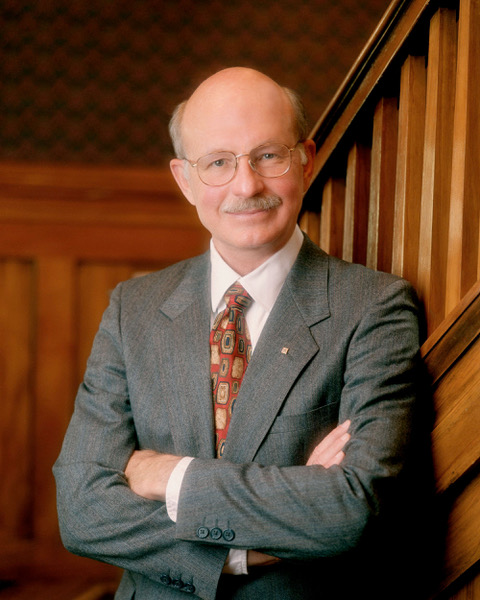
Gerald “Jerry” Stringfellow, former dean of the University of Utah’s John and Marcia Price College of Engineering and a pioneer in LED technology, passed away on October 3, 2025. He was 83.
Stringfellow was a Distinguished Professor in the Departments of Electrical and Computer Engineering and Materials Science and Engineering, serving two terms as the chair of the latter.
His research played a key role in the development of the colorful light-emitting diodes — LEDs — that are now ubiquitous in the way we see and interact with the world. From traffic lights to digital displays, the impact of Stringfellow’s fundamental contributions to technology can be seen every day.
Stringfellow’s achievements earned him numerous honors, including election to the National Academy of Engineering and the National Academy of Inventors, as well as being named a Life Fellow of the IEEE. He received the University of Utah Rosenblatt Prize, the Minerals, Metals and Materials Society’s John Bardeen Award, and the Governor’s Medal for Science and Technology. Stringfellow was especially proud to be honored in 2016 with the prestigious Frank Prize from the International Organization on Crystal Growth—awarded once every three years to a single researcher worldwide.
“But beyond his remarkable professional achievements, Jerry was beloved for his generosity, wisdom, mentorship, and warmth,” said Charles Musgrave, Dean of the Price College of Engineering. “He was a caring teacher, a skilled and thoughtful administrator, and a colleague who lifted others around him.”
Stringfellow was born in Salt Lake City, Utah in 1942, and was fascinated by science from an early age. His first love was chemistry, spending hours with a chemistry set he bought for himself with money from a paper route. Stringfellow began the pursuit in earnest with a bachelor of science degree in ceramic engineering from the U in 1964; he would go on to earn a M.S. and Ph.D. in materials science from Stanford University soon after.
Stringfellow was a group manager with Hewlett-Packard Labs in the 1970s when he began developing a new process to create LEDs with multiple colors that require much less power. He devised a process, called organometallic vapor-phase epitaxy, for the growth of new semiconductor alloys. In it, elements such as aluminum, gallium, indium and phosphorus are deposited on a substrate to create the crystals that illuminate red, orange, yellow and green LEDs. This work was immediately applied in HP’s handheld calculators, which used red LEDs for their displays.
In 1980, Stringfellow returned to the University of Utah, joining the Department of Materials Science and Engineering as a faculty member. While at the U, Stringfellow made considerable conceptual advances in the field of semiconductor manufacturing. In 1989, he published a book on his signature process, “Organometallic Vapor Phase Epitaxy: Theory and Practice,” now considered the standard for the science of growing LED crystals.
After the development of blue LEDs in the early 1990s by a trio of Japanese researchers, Stringfellow’s work began to be incorporated in a much wider array of applications, from computer screens to display lighting.
After two terms as Chair of the Department of Materials Science and Engineering, Stringfellow was selected as Dean of the College of Engineering in 1998.
“Stringfellow was an obvious choice to be dean because of his extensive industrial experience, his hugely successful research program, his proven leadership skills and his commitment to excellence,” said David Pershing, former dean and university president and then the Sr. Vice President for Academic Affairs who appointed Stringfellow as Dean. “By working together we were able to get the new John and Marva Warnock Engineering Building built.”
Beyond leaving his mark on campus, Stringfellow’s work as Dean made a lasting impact on Utah’s culture of supporting cutting-edge research. He was instrumental in the development of Utah’s 2001 Engineering and Computer Science Initiative. Then Governor Michael Leavitt’s goal was to double the state’s number of engineering graduates, and Stringfellow proposed a straightforward formula to achieve it: a 50% increase in the College’s base budget.
“The Engineering Initiative, as it ran from 2001 to 2024, funded the positions that about half of our faculty members now occupy,” said Richard Brown, who succeeded Stringfellow as Dean. “It also exceeded its original goal, facilitating a growth in the College that almost quadrupled the number of graduates.”
Stringfellow served until 2003, and remained active in research and academic service afterwards. In all, he published more than 400 scholarly papers and book chapters, garnering more than 15,000 citations over the course of an impactful research career. He retired and was named Professor Emeritus earlier this year.
Stringfellow met the love of his life, Barbara Farr, during his freshman year at West High School. They shared over 60 wonderful years, building their home, traveling the world, and raising their three children, Anne, Heather, and Michael. They jointly endowed a professorship in the Department of Electrical and Computer Engineering in 2023; the Gerald and Barbara Stringfellow endowed professorship is currently held by Florian Solzbacher.
A celebration of life will be held on campus in Stringfellow’s honor next year.